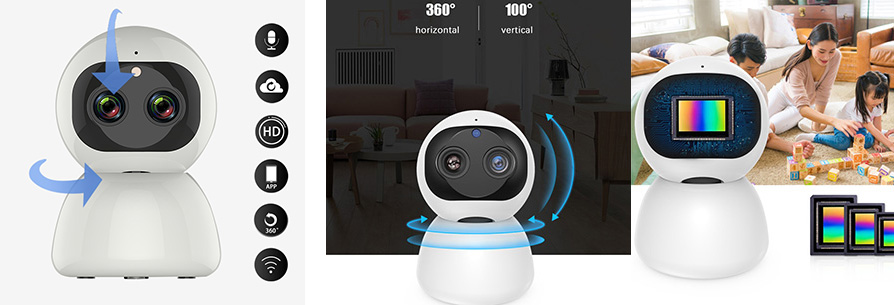CCTV Cameras
Enhancing Security with CCTV Cameras: A Comprehensive Guide
Introduction:
In today's rapidly evolving world, security has become a paramount concern for individuals, businesses, and communities alike. To ensure safety and deter potential threats, CCTV (Closed-Circuit Television) cameras have emerged as an indispensable tool. This article will delve into the world of CCTV cameras, discussing their benefits, types, installation considerations, and key features.
1. The Benefits of CCTV Cameras:
CCTV cameras offer numerous advantages, revolutionizing the way we approach security. This section highlights some key benefits:
a. Crime Prevention: The presence of CCTV cameras acts as a deterrent for criminals, reducing the likelihood of theft, vandalism, and other illicit activities.
b. Surveillance: CCTV cameras provide round-the-clock monitoring, enabling real-time surveillance and quick response to any suspicious activities.
c. Evidence Collection: In the unfortunate event of a crime, CCTV footage serves as invaluable evidence in identifying perpetrators and aiding investigations.
d. Employee Productivity and Safety: CCTV cameras promote a secure working environment, enhancing employee productivity and ensuring their safety.
2. Types of CCTV Cameras:
CCTV cameras come in various types, each designed for specific surveillance needs. Here are some commonly used types:
a. Dome Cameras: These cameras are discreet and suitable for indoor use. They provide a wide viewing angle and are often vandal-resistant.
b. Bullet Cameras: Bullet cameras are weatherproof and ideal for outdoor surveillance. They have a long range and are easily noticeable, acting as a visual deterrent.
c. PTZ Cameras: PTZ (Pan-Tilt-Zoom) cameras offer flexibility in monitoring large areas. They can be remotely controlled to pan, tilt, and zoom, providing a comprehensive view.
d. Thermal Cameras: Thermal cameras use heat signatures to detect objects, making them ideal for low-light conditions or detecting intruders in darkness.
3. Considerations for CCTV Camera Installation:
Installing CCTV cameras requires careful planning and consideration. Here are a few key factors to keep in mind:
a. Location: Identify strategic positions for camera placement to ensure optimal coverage and minimize blind spots.
b. Lighting Conditions: Assess lighting conditions in the area to select cameras that perform well in low-light or challenging environments.
c. Recording and Storage: Determine the required storage capacity for capturing and retaining footage, considering factors such as resolution, frame rate, and retention periods.
d. Privacy and Legal Compliance: Familiarize yourself with local regulations concerning privacy rights and ensure compliance when installing and using CCTV cameras.
4. Key Features to Look for in CCTV Cameras:
When choosing CCTV cameras, certain features can significantly enhance their effectiveness. Consider the following:
a. High Resolution: Opt for cameras with high-resolution capabilities to capture clear and detailed images, facilitating accurate identification.
b. Night Vision: Cameras equipped with infrared (IR) LEDs or low-light sensors ensure visibility in darkness or low-light conditions.
c. Remote Access: Look for cameras that offer remote access capabilities, allowing you to monitor footage from anywhere using smartphones or computers.
d. Motion Detection: Cameras with motion detection capabilities can trigger alerts or recordings when movement is detected, minimizing unnecessary footage.
Conclusion:
CCTV cameras have revolutionized the way we approach security, offering unparalleled protection and peace of mind. By understanding the benefits, types, installation considerations, and key features of CCTV cameras, individuals and businesses can make informed decisions to enhance their security measures. Invest wisely in CCTV cameras and take proactive steps towards a safer environment.
Exploring the Advantages of the PTZ 1080P High-Definition Binocular Dual-Lens IP Camera

Exploring the Advantages of the PTZ 1080P High-Definition Binocular Dual-Lens IP Camera
1. Crystal-Clear High-Definition Resolution:
The PTZ 1080P binocular dual-lens IP camera offers an impressive high-definition resolution, enabling users to capture and monitor images with exceptional clarity. This feature is particularly crucial in surveillance scenarios where visual details play a vital role in identifying objects or individuals.
2. Dual-Lens Design:
The dual-lens design is a standout feature of this IP camera. By integrating two lenses, it provides stereoscopic vision, mimicking human binocular vision. This enables accurate depth perception and more reliable object recognition, enhancing the overall surveillance experience.
3. IP Camera Connectivity:
Being an IP camera, the PTZ 1080P binocular camera can connect to a network, allowing remote access and control. Users can conveniently monitor and manage the camera's settings from a centralized location, which is particularly useful for large-scale surveillance setups.
4. Intelligent Tracking and Analytics:
Equipped with intelligent tracking and analytics capabilities, this camera goes beyond mere video capture. It can automatically detect and track moving objects, eliminating the need for manual monitoring. Additionally, the camera can analyze captured data, providing valuable insights and statistics for security purposes.
